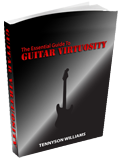We've all heard the smooth grooves that originate from the calm demeanor of a rum sipping island country known as Jamaica. Of course the groove that I'm talking about is none other than Reggae music. Jamaica is a self reliant country, where they create their own entertainment, and the music scene that's currently their is very diverse.
Jamaica's charm is quite contagious, and the original concepts of Reggae music, and all of its many sub-genres, have spread far and wide. It was this amazing influence that gave us Ska music, and fantastic bands like No Doubt.
So what is it that makes Reggae music really tick? well its actually
very simple.
The chords
In my opinion, when it comes to Reggae guitar and the matter of the chords, you can pretty much use any chord that you like. However, your run of the mill major and minor chords are most used. I find that Major and Minor 7th chords work the best, and these are the same chords that are often times found in other rhythmic styles of music, specifically Latin guitar.
The rhythmic structure
This is where Reggae music really gets that sound, and which is why I wrote this article for the guitarist. A lot of guitar players have trouble with the odd timing of Reggae music, because even if they try to jump in, they tend to have a hard time fitting the chords in on the right beat.
In order to get this down, try imagining a simple drum beat at a slow tempo. This drum beat will use alternating hits on the snare and bass drum, and will look something like this:
1 & 2 & 1 & 2 &
All the ones are bass drum hits, while the in between and symbols are snare hits. This is the most common and basic drum structure, and is used across many styles of music, including most modern day House music.
Here's where Reggae music differentiates from other styles of music. In most western styles of music, a guitar chord will generally come in on every other first beat, lining up with the bass drum, while pausing on the "and" beat, or snare hit.
In Reggae music, its just the opposite. There's a pause on the actual numbered beats, and the guitar chords are struck on the and beats. You could look at it like this:
& 1 & 2 & 1 & 2
Try counting out loud the 1 & 2 beat, then count aloud the & 1 & 2 beat. When you get to the Reggae beat, something interesting happens. Unless you are very familiar with Reggae music and playing Reggae guitar, you'll probably notice that your synchronization of going from the more western beat to the Reggae beat is a little off.
Chances are that when you go to the Reggae beat, you'll probably sound it out at a much faster tempo than the more western beat.
This is where things tend to get tricky. The best remedy for this is to start tapping your foot as your working on Reggae guitar. The choice is yours. You can start tapping your foot on the first beat, or you can tap your foot on the second beat, where the guitar actually comes in.
Now lets look at some chords, shall we?
I created a very simple example of a Reggae song, basically patterned off of any Bob Marley piece. This example is in a minor key and will use the chords of Bm7, Em7, and A7, and in that order. 
Dec 22, 2008
The basics of Reggae guitar
Subscribe to:
Post Comments (Atom)


